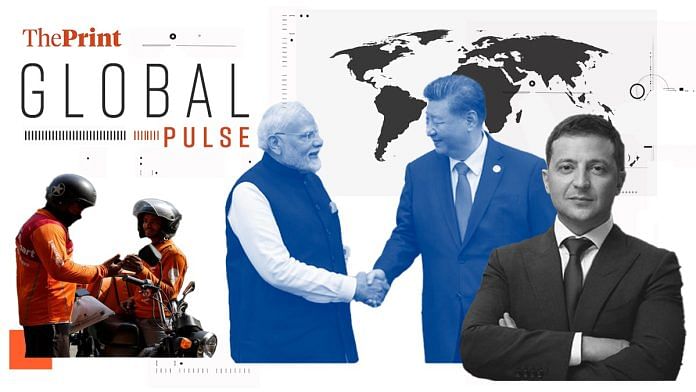New Delhi: An editorial in the Global Times calls for stability in the India-China relationship after recent developments—an understanding, it believes, the two countries share. India and China, it says, are committed to resolving their differences through “peaceful consultation” in response to the “earnest hopes of the international community”.
India-China ties have never been unidimensional nor bound by a “dragon vs. elephant rivalry narrative”, the editorial says, summing up that the latest agreement simply offers a new, stable platform to build cooperation in different areas. The editorial’s summation comes from considering several Indian media outlets expressing “positive expectations” about India-China cooperation in sectors such as passenger flights, electronics manufacturing, pharmaceuticals, electric vehicles, etc.
But before getting ahead of itself, the editorial offers a word of caution: “This reminds us that while the deadlock has been broken, and a return to normalcy is anticipated, bridging gaps and rebuilding trust will take time and patience.” The many eyes from the international stage on India and China call for “greater wisdom” from both sides in solving problems.
The best way for India and China to reduce “future fluctuations” and minimise “geopolitical disruptions” from countries with “hidden malicious intent” is open communication and mutual respect for all agreements and treaties signed, according to the Global Times.
“The current resolutions must not be viewed as mere ‘tactical de-escalation‘ for expedience, a bargaining chip with third parties, or leaving room for ‘unilateral interpretation‘ in the future, as this could lead to new strategic misjudgments,” the editorial says.
Both sides will ideally “make good use of the opportunities provided by the current solution”, the editorial hopes. “Only in this way can we be responsible for the well-being of our two peoples, as well as for the stability and development of the world,” it concludes.
Not only China but also Ukraine thinks good relations with India are essential for the world’s stability.
Politico reports on the interview Volodymyr Zelenskyy gave The Times of India, saying that New Delhi is a key global player and could bring Moscow to the negotiating table.
“Ukraine has come to increasingly view India—the world’s most populous nation, which has long promoted non-alignment in its foreign relations—as its ideal intermediary in dealings with the Kremlin,” Politico writes.
India has refrained from condemning Russia for the Ukraine war, even pursuing a friendly relationship with Moscow. However, Politico notes how India has also spoken in support of respecting territorial integrity.
“Zelenskyy signalled Monday that he was open to New Delhi spearheading peace talks, saying they could ‘undoubtedly‘ take place in India,” Politico writes. But he added that India could “put pressure on Moscow in other ways”, such as blocking Russia’s economy, cheap energy resources, and defence-industrial complex.
The question is whether India can pull off its balancing act with the weight of such expectations piled on it.
The Financial Times takes the global community to a folk festival in the shadow of Mehrangarh Fort, where folk artists have arrived from across the world to celebrate traditional forms of music in the desert sands.
More than 400 performers played at the Rajasthan International Folk Festival in Jodhpur, FT reports. Besides Indian folk artists, musicians from Norway, Estonia, Azerbaijan, Mauritius, and Korea also attended.
“A sunrise concert on a high plateau near the fort starts at 5.30 am, the pre-dawn sky dark, the musicians barely visible. As the Moon recedes, glowing like a sunset, the five players become silhouettes. Then the sun catches their red turbans while the air grows noticeably warmer,” FT writes.
Maharaja Gaj Singh II makes an appearance too. “Indeed, part of RIFF’s success has been in giving folk musicians the respect they deserve,” the FT reports. “The Maharaja admits that, in former times, folk musicians were at the bottom of the pecking order, and many of them wouldn’t have been allowed into the fort.”
While FT rediscovers some of the oldest of Indian musical traditions,
Bloomberg offers an opinion on one of India’s newest traditions—instant 10-minute delivery.
A lot can go wrong when everything arrives in 10 minutes, writes Andy Mukherjee in his Bloomberg column. Indians today are all too reliant on Blinkit, Zepto, and Swiggy Instamart. “But what might seem like a gain for consumers is not a free lunch for the society. A 10-minute delivery has many hidden costs,” he writes.
Quick commerce has engulfed the Indian market. However, its economics might not withstand the relentless pressure of growth, especially as smaller cities and towns also become players. The cost of warehousing goods in such areas will outstrip their demand.
“So far, though, the Indian model has shown surprising resilience. It’s as if COVID-19 flipped an impulse-buying switch in people’s heads,” Mukherjee admits. “The origin of India’s quick-commerce revolution is not purely psychological. It’s also financial, economic and social.”
Quick commerce is creating low-quality jobs amid rampant unemployment—what Bloomberg terms a “jobless recovery”. Labour conditions are slightly better than other gig work but not much, and the traditional retail supply chain is unhappy as instant delivery apps bypass it.
“A lot can go wrong when 1.4 billion consumers start expecting even household appliances to arrive in 10 minutes and are not willing to take stock of the consequences of their impatience,” writes Mukherjee. “They might get more than they bargained for when the doorbell rings.”
(Edited by Madhurita Goswami)
Also Read: Global media on the path beyond India-China détente & what’s behind ‘politicisation of Indian food’






